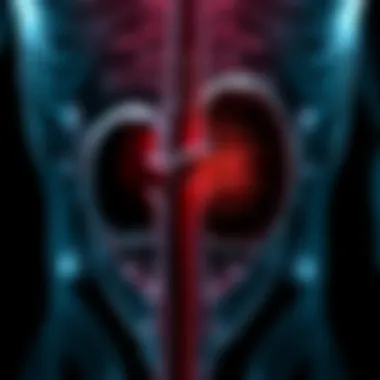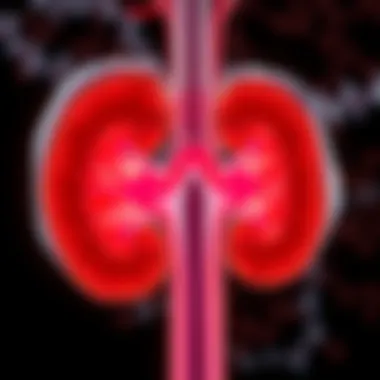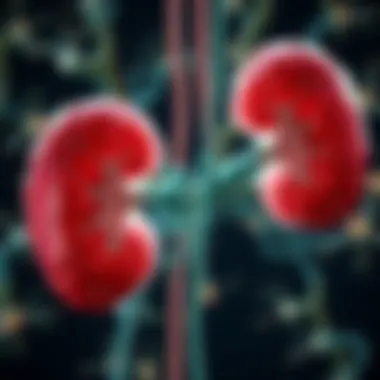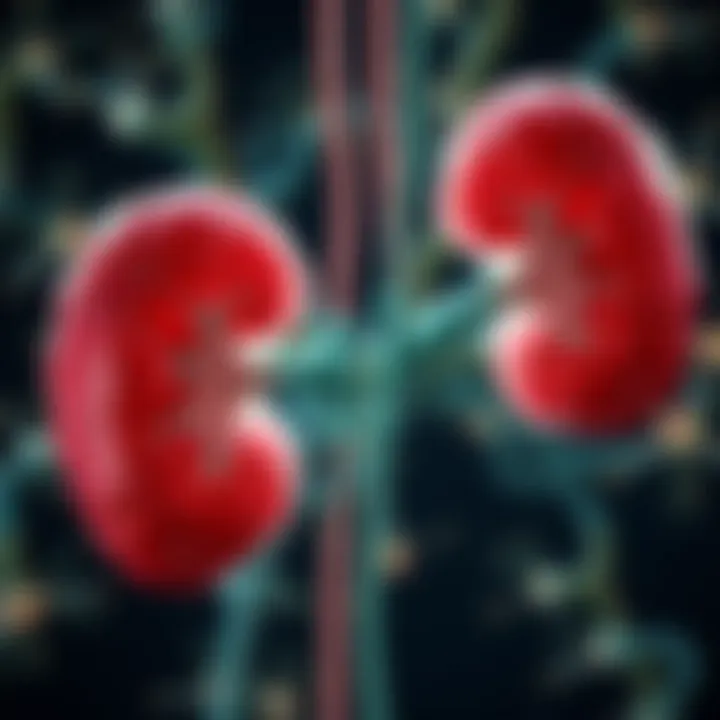Exploring Kidney Repair Mechanisms and Treatments


Intro
Understanding the intricate workings of kidneys is paramount, especially when it comes to their remarkable resilience and ability to heal. Kidneys are not just bean-shaped organs that filter blood; they play multifaceted roles in maintaining homeostasis, regulating blood pressure, and ensuring the balance of electrolytes. Even in the face of injury, their potential to withstand damage and recover warrants close examination.
This exploration digs deep into how kidneys operate, the pathways they take when undergoing repair, and the pathways through which innovative medical strategies are transforming the landscape of nephrology. Modern science is unearthing methods that could radically change the prognosis for patients with kidney conditions, raising hopes for improved recovery outcomes.
The relevance of this study is substantial. As kidney diseases remain a leading cause of morbidity worldwide, understanding how to catalyze repair mechanisms can pave the way for more effective treatments. There’s a lot to discuss and link together, from foundational biological mechanisms to cutting-edge therapeutic developments. By examining these facets, we can glean insights into the future of nephrology, providing a roadmap not only for healthcare professionals but also for everyday individuals seeking knowledge about their kidney health.
Next, we will explore the methodologies employed in current research.
Understanding Kidney Anatomy and Function
Understanding the anatomy and function of the kidneys plays a crucial role in grasping their repair potential. The kidneys, two bean-shaped organs nestled in the lower back, are not just filtration systems; they're central players in maintaining homeostasis in the body. Recognizing their complex structure and physiological roles enriches our comprehension of how various disorders may impact kidney functionality and how they might recover from damage.
Anatomical Structure of the Kidneys
The kidneys are intricately designed, comprising several key components that work together flawlessly. Each kidney features:
- Cortex: The outer region that houses the majority of the nephron structures, where filtration begins.
- Medulla: The inner part, consisting of renal pyramids that converge at the renal pelvis, assisting in urine collection.
- Nephrons: The functional units, roughly a million in each kidney, where blood filtration, reabsorption, and secretion occur.
- Renal Pelvis: The funnel at the center of each kidney, directing urine into the ureter.
This construction enables the kidneys to carry out multiple functions, from filtering waste products from the blood to regulating electrolyte balance. The kidneys also help stabilize blood pressure through the renin-angiotensin system. Visualize the kidneys as a sophisticated wastewater treatment facility – they work tirelessly, often without any notice, to keep the body's internal environment in check.
Physiological Role of Kidneys
The physiological roles of the kidneys extend far beyond mere filtration. These organs are vital in multiple domains:
- Waste Excretion: Kidneys filter out toxins and metabolites, including urea and creatinine.
- Fluid Balance: They manage water retention and loss, helping maintain proper hydration levels.
- Acid-Base Balance: They regulate bicarbonate and hydrogen ion concentrations, ensuring the blood remains at a neutral pH.
- Electrolyte Regulation: Key electrolytes such as sodium, potassium, and calcium are monitored and adjusted as needed.
- Hormonal Production: The kidneys secrete erythropoietin, which stimulates red blood cell production in the bone marrow and also synthesis of calcitriol, the active form of vitamin D.
The kidneys are not just filtering organs; they are also hormonal regulators that play critical roles in overall homeostasis.
Understanding these functions is pivotal, especially when exploring repair mechanisms. Each physiological activity is intertwined with the kidney's ability to recover from injury. For example, if the kidneys are forced to deal with significant trauma or disease, the knowledge of their basic functions will inform treatment strategies while offering insight into their regenerative capabilities. This foundation sets the stage for the subsequent discussions on kidney disorders and the possibilities for repair.
Common Kidney Disorders
Understanding common kidney disorders is essential for both healthcare professionals and patients. The kidneys serve as vital organs in the body, and any disruption in their function can lead to significant health implications. Such disorders not only affect the kidneys but can also impact the overall wellbeing and quality of life. Through this section, we will explore three major kidney conditions: Chronic Kidney Disease, Acute Kidney Injury, and Kidney Stones and Obstructions, shining a light on their symptoms, causes, and implications for treatment and repair potential.
Chronic Kidney Disease
Chronic Kidney Disease (CKD) is a gradual loss of kidney function over time. It often sneaks up on individuals, with symptoms developing slowly. According to the National Kidney Foundation, more than 37 million adults in the U.S. are estimated to have CKD. The leading causes include diabetes and high blood pressure, both of which can lead to damage over time.
CKD can have far-reaching effects, not just limited to the organs themselves. As kidney function declines, waste and excess fluid can build up in the body, leading to complications such as hypertension, anemia, and bone disease. Left unchecked, it can progress to End-Stage Renal Disease (ESRD), necessitating dialysis or transplantation.
Moreover, managing CKD requires understanding its progression stages, from mild loss of function (Stage 1) to severe impairment (Stage 5). For many patients, dietary adjustments, regular monitoring, and lifestyle modifications play pivotal roles in slowing disease progression. Understanding the intricate mechanisms of renal repair in CKD remains a hot topic in nephrology, with potential advances in treatment aiming to regenerate kidney tissue.
"With the right interventions, the management of chronic kidney disease can be a marathon, focusing on patience and gradual improvement rather than a sprint."
Acute Kidney Injury
Acute Kidney Injury (AKI) presents a sharp decline in kidney function, often occurring abruptly over a few hours to days. It often stems from various causes, including dehydration, severe infections, or reactions to medications. Unlike CKD, AKI can be reversible if caught early and treated appropriately.
Key indicators of AKI include a sudden decrease in urine output and elevated levels of creatinine in the blood.
There are three main types of AKI:
- Prerenal: Due to inadequate blood flow to the kidneys.
- Intrinsic: Resulting from direct damage to the kidneys.
- Postrenal: From obstructions that hinder urine flow.
Clinicians often emphasize the importance of timely intervention and identifying the underlying cause to facilitate recovery. Some patients, however, may experience lasting damage that raises the risks for CKD later on. Exploring the repair capabilities of kidney cells following AKI is an ongoing area of research.
Kidney Stones and Obstructions
Kidney stones are solid masses made of crystals that can form in the kidneys. They arise from various factors, including diet, genetics, and certain medical conditions. Small stones may pass unnoticed, but larger ones can cause significant pain, often described as one of the worst pains imaginable. Symptoms can include back pain, blood in the urine, and frequent urination.
There are several types of kidney stones, including:
- Calcium stones: The most common, typically formed from excess calcium in urine.
- Struvite stones: Often develop after a urinary tract infection.
- Uric acid stones: Formed when urine is too acidic.
- Cystine stones: Result from a genetic disorder that causes the kidneys to excrete too much amino acid.
Obstructions can also occur without stones, stemming from tumors or anatomical abnormalities that prevent urine from draining effectively. The repair process in cases of obstruction involves not only reversing the blockage but also assessing any renal damage that may have occurred. In severe cases, surgical intervention may be necessary to restore kidney function. It's critical to adopt preventive measures, including dietary improvements and hydration, to lower the risk of recurrence.
In summary, recognizing these common kidney disorders is a vital component of understanding kidney health and the potential for repair. Early detection and management can be the keys to preserving function and enhancing the quality of life.
Mechanisms of Kidney Repair


Understanding the mechanisms behind kidney repair is crucial for advancing therapeutic practices in nephrology. By exploring the intricate ways in which kidneys can heal themselves, we can better harness both their inherent regenerative capabilities and the external factors that can enhance or hinder these processes. This section aims to shed light on the natural repair pathways of the kidneys, along with external influences that play a pivotal role in kidney health. This knowledge is not just for academics or practitioners, but also for anyone invested in understanding the broader implications for patient care and recovery.
Intrinsic Regenerative Potential
The intrinsic regenerative potential of the kidneys refers to their ability to heal and restore function following injury or damage. Kidneys, unlike some organs, have a remarkable, albeit limited, capability to regenerate. This means that when tissues sustain damage—due to conditions like hypertension, diabetes, or physical trauma—the kidneys can respond to a certain extent, repairing themselves through various cellular mechanisms.
Here are some key elements of this intrinsic capability:
- Cell Proliferation: After injury, certain types of kidney cells can proliferate to replace damaged cells. This is especially true in the proximal tubules, where epithelial cells can undergo division to help restore the nephron.
- Stem Cell Activation: Research suggests that resident stem cells may play a role in kidney repair. These cells can possibly differentiate into specialized renal cells needed for regeneration, bouncing back from injury.
- Signaling Pathways: Complex signaling mechanisms guide kidney repair processes. For instance, pathways like the Wnt/β-catenin pathway are instrumental in promoting cell survival during repair phases after acute injury.
Despite these regenerative abilities, the effectiveness of intrinsic repair varies significantly among individuals and depends on the overall health of the kidney tissue. Some recurrent conditions may overwhelm these mechanisms, leading to chronic damage over time. Thus, understanding the nuances of intrinsic repair is paramount for both clinicians and researchers.
Extrinsic Factors Influencing Repair
While intrinsic mechanisms are vital, extrinsic factors also influence kidney repair potential. These include environmental aspects, medical interventions, and lifestyle choices. A comprehensive approach brings to light how these external elements can either support or impair kidney regeneration:
- Diet and Nutrition: A balanced diet rich in antioxidants can bolster kidney health. Nutritional factors can mitigate oxidative stress, which is detrimental to kidney cells during injury.
- Physical Activity: Regular exercise has been linked to improved kidney function. It enhances blood circulation and may promote better repair through improved oxygenation and nutrient delivery to renal tissues.
- Medication and Treatment Protocols: The use of specific medications can either alleviate underlying risk factors for kidney damage or can, in some cases, introduce new risks. For example, nephrotoxic drugs can hinder the kidneys’ ability to repair by causing further injury.
- Surgery and Procedural Interventions: Surgical options, like nephrectomy or kidney transplant, can lay a foundation for healing through techniques that remove damaged tissues or replace lost functionality.
"Effective kidney repair entails a multifaceted interaction between intrinsic capabilities and extrinsic influences. Recognizing this interplay can lead to improved patient outcomes."
Understanding these external factors can empower clinicians to develop holistic treatment plans. Not only can they address existing kidney issues, but they can also enhance the body's natural repair mechanisms. The goal here is to foster an environment conducive to healing, promoting integrated care strategies that encompass both medical and lifestyle interventions.
Current Interventions and Treatments
The landscape of kidney treatments has evolved significantly, shedding light on countless possibilities for improving overall kidney health. With the backdrop of increasing instances of kidney-related conditions among the population, understanding current interventions and treatments emerges as a cornerstone in recognizing how we can harness and amplify the renal repair potential of kidneys. The relevance of this section focuses on practical strategies and options available to both healthcare providers and patients. Recognizing the ways these interventions act not only provides help to those who suffer from kidney diseases but also plays a crucial role in informing ongoing research for the future.
Pharmacological Approaches
When it comes to pharmaceutical interventions, a multitude of options exists aimed at mitigating kidney disease impact. Pharmacological approaches are typically centered on managing symptoms, addressing underlying conditions, and preventing further damage. For instance, medications that control blood pressure, such as ACE inhibitors and angiotensin II receptor blockers, play integral roles in protecting the kidneys from damage caused by hypertension. Moreover, the use of erythropoiesis-stimulating agents can aid those with chronic kidney disease (CKD) by facilitating the production of red blood cells, combating anemia often associated with renal impairment.
In addition to these primary drugs, there is growing interest in nephroprotective agents that can specifically shield kidney function. SGLT2 inhibitors are a noteworthy example; initial studies suggest they might not only manage diabetes but also provide a protective effect on the kidneys. This is vital because with the rise of diabetes-related kidney complications, identifying multi-functional medications becomes ever more crucial. Furthermore, ongoing trials examine combinations of existing drugs, seeking coherent approaches that maximize benefits.
Dialysis and its Implications
Dialysis stands as a lifesaving option for those with end-stage renal disease (ESRD). By artificially filtering blood, dialysis provides patients who can no longer depend on their kidneys for waste removal a second chance at health. There are two primary types—hemodialysis and peritoneal dialysis. Hemodialysis involves using a machine to direct blood through a filter, while peritoneal dialysis uses the lining of the abdominal cavity to filter blood internally.
However, while dialysis is beneficial, it is not without implications. Quality of life can be significantly impacted due to the time required for treatments, often leading to emotional and physical strain. Moreover, patients undergoing dialysis also remain at risk of complications such as infection, cardiovascular issues, and even dialysis-related toxicity if not properly managed. These challenges underscore the need for ongoing research into augmentation strategies and better alternatives that could simplify or improve patient experiences.
Kidney Transplantation
Kidney transplantation remains the gold standard treatment for patients with irreversible kidney failure. While not all individuals are suitable candidates for transplantation, this surgical option can restore normal kidney function and vastly improve a patient’s quality of life. Potential donors can be living or deceased, and advances in immunosuppressive therapies have significantly reduced transplant rejection rates.
However, it is essential to recognize the challenges associated with kidney transplantation. The need for lifelong immunosuppressive therapy to prevent organ rejection places patients at risk for other health issues. Furthermore, access to transplantation can be a significant barrier, with waiting lists often stretching years, emphasizing the inequities in organ allocation. Alongside these concerns arise ethical discussions surrounding donor consent and the balance between the needs of recipients and the risks to donors.
In summary, the current landscape of kidney interventions encompasses a broad range of treatments that pivot on patients' individual needs, conditions, and responses. Gaining insight into pharmacological strategies, understanding the realities of dialysis, and weighing the pros and cons of transplantation help enrich our comprehension of kidney health management. As research continues, the ultimate goal remains steadfast: unlocking the full repair potential of kidneys for a healthier future.
The journey through kidney disorders is not just about treatment but understanding and improving the quality of life.
For a deeper dive into nephrology advancements, resources such as Wikipedia, Britannica, and Kidney.org offer extensive information.
Innovations in Nephrology
The field of nephrology is rapidly evolving, propelled by groundbreaking research and novel technologies aimed at understanding and improving kidney health. Innovations in nephrology are crucial as they not only pave the way for new treatments but also hold the potential to significantly enhance the quality of life for individuals suffering from kidney-related ailments. Given the rising prevalence of chronic kidney diseases worldwide, these advancements come at a critical juncture.
The integration of cutting-edge techniques such as stem cell research, gene therapy, and tissue engineering into clinical practice is fostering an environment ripe for improving kidney repair. These innovations promise to broaden our understanding of renal functioning while also offering targeted therapies that may revolutionize how we approach kidney health.
Stem Cell Research
Stem cell research has emerged as a beacon of hope in the nephrology landscape. The unique regenerative capabilities of stem cells make them a valuable asset in repairing damaged kidney tissue. The utilization of pluripotent stem cells, which can differentiate into various cell types, offers the potential to replace dysfunctional renal cells.
Clinical studies have demonstrated that stem cells can lead to significant functional recovery in preclinical models of kidney injury. This ability to restore renal function could shift the paradigm from management to cure—a game changer in treating chronic conditions such as glomerulonephritis or diabetic nephropathy. Moreover, the ethical considerations surrounding stem cell sources, particularly regarding embryonic versus adult stem cells, continue to be pivotal discussions in the field.
Gene Therapy Applications
Gene therapy represents another revolutionary approach in nephrology. The objective is simple: to correct defective genes responsible for kidney diseases, thus preventing or treating the conditions at their root. Methods employing viral vectors to deliver therapeutic genes directly to target tissues have shown promise in experimental settings. For example, studies focusing on conditions like Alport syndrome or cystic kidney disease exhibit substantial progress in gene correction strategies.
However, the application of gene therapy in routine practice faces several challenges, including delivery efficiency, potential immune responses, and long-term effectiveness. Despite these hurdles, the potential implications are profound. Successfully deploying gene therapy could not only provide immediate relief from symptoms but also potentially eradicate certain hereditary conditions altogether, leading to a future where genetic predispositions to kidney disease may not be an irreversible fate.
Tissue Engineering of Kidneys
Tissue engineering is yet another frontier in nephrology, merging biology with engineering principles to create functional kidney tissue in vitro. The idea is to produce artificial kidneys or repair damaged ones through biocompatible scaffolds that support cell growth and differentiation. Researchers are experimenting with 3D bioprinting techniques, which offer a promising avenue for creating kidney structures that mimic natural anatomy and function.


In recent studies, success in generating kidney organoids from stem cells has showcased the potential of this technique for both drug screening and kidney transplantation. These miniaturized organs could serve as models to test therapeutic interventions more accurately. Moreover, they could address the shortage of donor kidneys, providing a viable alternative source for transplant patients.
The combination of stem cell research, gene therapy, and tissue engineering embodies the future of kidney repair—the capability to fundamentally change how we manage kidney health.
Lifestyle and Kidney Health
The conversation around kidney health often zeroes in on medical treatments and advancements. However, it's equally vital to discuss lifestyle choices that can greatly influence kidney function. Factors such as diet, hydration, and physical activity play integral roles in maintaining kidney health, serving as both preventive measures and supportive therapies for those dealing with existing conditions. A healthy lifestyle isn't just a nice-to-have; it’s a must-have that can significantly affect kidney repair potential and overall wellness.
Diet and Nutrition
Diet is a cornerstone of health, and when it comes to the kidneys, what you eat can make all the difference. Consuming a balanced diet that includes plenty of vegetables, fruits, and whole grains is crucial. These foods provide essential vitamins and minerals, and most importantly, fiber, which helps keep blood sugar and cholesterol levels in check.
It's wise to limit the intake of sodium and cholesterol-laden foods, which can place additional stress on the kidneys. Foods high in saturated fat and processed sugars can lead to weight gain and worsen kidney function over time. Incorporating lean proteins, such as salmon and chicken, instead of red meats can also be beneficial. Imagine eating a colorful array of vegetables daily; not only does it contribute to better health, but it also delights the palate.
"A diet rich in fruits and veggies not only pleases the taste but nourishes the body, especially the kidneys."
Additionally, some individuals may need to follow specific dietary plans tailored to their kidney health, such as the DASH diet or renal diet. These plans often emphasize reducing potassium and phosphorus while maintaining adequate protein intake. Always consult a healthcare provider or dietician before making drastic changes to your diet.
Hydration and Its Impact
Staying hydrated is critical for kidney function. Water helps the kidneys filter waste from the blood, making hydration an essential factor in their repair and overall health. However, the right amount can depend on various factors, including body size, activity level, and existing health conditions.
Drinking adequate water throughout the day can help dilute the substances in the urine that lead to kidney stones and infections. It's not a one-size-fits-all scenario; some people may need to limit their fluid intake if they have certain kidney issues, while others may need to drink more. Listening to your body is key. If you feel thirsty, quench it!
Here’s a quick rundown of hydration tips:
- Aim to drink at least eight to ten glasses of water a day.
- Include hydrating foods such as cucumbers, watermelon, and oranges in your diet.
- Monitor the color of your urine; a light yellow color typically indicates good hydration.
Understanding your own body's needs can go a long way in maintaining proper hydration and supporting kidney functions.
Physical Activity and Kidney Function
Incorporating regular physical activity into your routine can serve as a natural boon for your kidneys. Physical exercise has far-reaching effects, not just on weight management but also on blood pressure regulation and improving cardiovascular health, both of which are linked to kidney well-being.
Engaging in practices like walking, cycling, or swimming can enhance blood flow to the kidneys, supporting their ability to filter blood efficiently. Even moderate activities, such as gardening or taking the stairs, can make a difference.
Consider the following recommendations for physical activity:
- Aim for at least 150 minutes of moderate aerobic exercise each week.
- Strength training activities should be included at least two days a week.
- Consider activities that you enjoy to stay consistent and maintain motivation.
Being physically active is not just about losing weight; it's about cultivating a lifestyle that nourishes your kidneys and contributes to overall health. Keeping active will also positively influence your mental state, making you feel good inside and out. Stay curious, and explore the activities that bring you joy—it’s your journey to health.
The Role of Genetics in Kidney Repair
Genetics play a significant role in kidney health and repair, influencing both susceptibility to kidney diseases and the body’s regenerative capabilities. Understanding how genetic factors impact kidney function can lead to better prevention strategies and treatment options. As nephrology continues to evolve, the integration of genetic research is becoming increasingly critical in understanding kidney repair.
Genetic Predispositions to Kidney Diseases
Many kidney diseases have a hereditary component, where individuals inherit mutations that may predispose them to conditions such as chronic kidney disease or polycystic kidney disease. For example, individuals with a family history of kidney disorders often face a higher risk of developing similar issues, suggesting a direct link between genetics and kidney health.
- Familial patterns: Certain kidney diseases, like Alport syndrome and Fabry disease, are well-documented hereditary disorders. These conditions can manifest early in life and cause significant kidney damage.
- Detecting risks: Genetic screening can provide valuable information about a person's likelihood of developing kidney problems. Knowing one's genetic makeup can empower individuals to take preventive measures before significant damage occurs.
- Genetic markers: Research has identified specific genetic markers associated with compromised kidney function. For instance, genes involved in glomerular filtration may notably impact how kidneys filter blood.
By understanding these genetic predispositions, both patients and medical professionals can adopt informed lifestyle changes and interventions that may enhance kidney health or extend functional longevity.
Hereditary Factors in Kidney Regeneration
The regenerative ability of kidneys is not just a matter of individual health; hereditary factors can also influence how effectively kidneys can heal and regenerate after injury or illness. Some families possess genetic traits that enhance their ability to recover from kidney damage.
- Regenerative genetics: Studies have proposed that certain genes may dictate the rate at which cells can regenerate after injury. For instance, the Klotho gene has been shown to play a role in cellular aging and kidney regeneration.
- Animal models: Much research in genetics and kidney healing has utilized animal models to study these hereditary traits. For example, specific strains of mice have shown contrasting abilities to regenerate kidney tissue effectively following injury, offering clues about the underlying genetic mechanisms.
- Therapeutic potential: Recognizing which hereditary factors optimize or impair repair processes can guide efforts in personalized medicine. This could lead to focused therapies that enhance those regenerative capabilities even in patients with less favorable genetic backgrounds.
In summary, the genetics associated with kidney disease and regeneration is a complex web that intertwines predispositions with recovery potential. A nuanced understanding of these genetic factors can reshape nephrology’s approach toward prevention, diagnosis, and treatment of kidney-related disorders.
Future Directions in Kidney Repair Research
Research into kidney repair is crucial as it opens up avenues for better treatments and enhances our understanding of kidney health. This area of inquiry encapsulates not just the clinical implications, but also aligns with shifts in medical technology and patient care paradigms. The goals include optimizing existing treatments and exploring novel therapies that harness the inherent capabilities of kidneys to regenerate and repair themselves.
Emerging Technologies
As we step forward, several emerging technologies are setting the stage for revolutionary changes in kidney repair strategies. One paramount area is the utilization of wearable biosensors. These devices can monitor kidney function in real-time, offering insights that were previously unattainable outside a clinical setting. Such continuous monitoring is not just a luxury; it can radically alter treatment pathways based on immediate data, leading to timely interventions.
Additionally, nanotechnology is making waves, particularly in drug delivery systems. By utilizing nanoparticles, researchers can target specific cells within the kidneys, enhancing the efficacy of medications while minimizing systemic side effects. This targeted approach represents a significant shift from the one-size-fits-all model that has long dominated nephrology.


- 3D Bioprinting of kidney tissues is another exciting frontier. This technology can create scaffolds that mimic the unique architecture of the kidney, enabling researchers to study kidney function in controlled environments. As a result, it holds the promise of advancing not only basic research but also regenerative medicine.
"Emerging technologies provide unprecedented opportunities to address kidney diseases, potentially shifting from management to cure."
Interdisciplinary Approaches
The path to advancing kidney repair is increasingly integrating multiple disciplines, which emphasizes a more holistic view of kidney health. The intersection of genetics, bioengineering, and data science is especially promising. Geneticists are collaborating with nephrologists to identify specific genetic markers associated with kidney diseases. These markers can help predict susceptibility to conditions such as chronic kidney disease, thus allowing for preemptive measures in at-risk populations.
Besides, this merging of fields facilitates the collection and analysis of vast datasets to identify patterns that can lead to novel insights regarding kidney function and health. For instance, data scientists can use machine learning algorithms to sift through mountains of patient data to uncover trends that inform better treatments. This collaborative approach not only enriches the research but broadens the perspectives that inform future innovations.
Moreover, education plays a pivotal role in these multidisciplinary efforts. Training healthcare professionals to understand the integrated nature of kidney health can foster better patient outcomes and more empathetic care.
Patient Perspectives on Kidney Repair
Understanding patient perspectives on kidney repair is crucial in shaping treatment pathways and improving outcomes for individuals facing kidney disorders. It is not just about the medical interventions; it’s about the lived experiences that inform how patients interact with their health, make decisions, and perceive their quality of life. Listening to patients provides invaluable insights that can lead to more personalized and effective care strategies.
Experiences with Chronic Kidney Conditions
Patients living with chronic kidney disease often find themselves on an emotional rollercoaster. The diagnosis can be shocking, ushering in a flood of questions and uncertainties. Patient experiences illustrate the stark reality of kidney disease. Many face ongoing fatigue, fluid restrictions, or dietary changes that can feel like a straitjacket. Their daily realities often include frequent hospital visits, complex medication regimens, and the looming possibility of dialysis or transplant.
During interviews, patients have expressed frustration with the lack of clear communication from providers. For instance, one individual recounted a feeling of abandonment after being diagnosed. They wished for more information about what to expect, available treatments, and ways to manage their symptoms. These experiences highlight the need for healthcare systems to enhance communication around treatment options and what they entail.
However, it’s not all despair. Some patients find strength in support groups. Sharing stories and tips for managing life with kidney disease fosters a sense of community. That support can turn a daunting journey into a shared experience. Furthermore, many discover newfound resilience and advocacy skills. They become vocal about their needs, pushing for better care protocols and research prioritization.
Quality of Life Implications
Quality of life is a complex tapestry woven from various threads: emotional, physical, and social influences. Chronic kidney conditions impact all these areas profoundly. Patients who are heavily involved in treatment decisions often report better satisfaction with their healthcare. They feel more empowered when they understand their options and can choose paths that align with their lifestyles and values.
The implications for quality of life can vary dramatically among individuals. Some report a loss of independence, feeling tethered to treatment schedules or dietary restrictions. Others acknowledge an altered perspective on life, finding deeper appreciation in daily interactions and seemingly simple pleasures.
"I never thought I’d find joy in a simple cup of herbal tea. But now, each sip reminds me to slow down and savor the moment."
Healthcare professionals need to recognize that the relationship between kidney function and quality of life is reciprocal; as one deteriorates, it can pull the other down as well. Involving patients in discussions about their health, and recognizing the emotional facets of living with kidney issues, can lay the groundwork for more holistic care approaches.
As research advances, understanding these personal perspectives will become increasingly vital in developing effective treatments and improving the quality of care. It’s not just about saving kidneys; it’s about preserving the life and well-being of the individuals who rely on them.
Ethical Considerations in Kidney Treatments
When discussing kidney treatment, the conversation quickly turns to the ethical considerations involved. This theme holds paramount importance not just in the medical field but also in society at large. Ethical discussions around kidney health often pivot on key points like access to treatment, fairness in transplantation practices, and the implications of emerging technologies.
Addressing these ethical issues can help ensure that all patients receive appropriate care while also maintaining the integrity of the medical profession. It encourages a broader discussion about who gets access to life-saving procedures, making sure that decisions are made equitably and justly.
Access to Care and Equity
Access to kidney treatment isn’t merely a clinical issue; it is intertwined with social justice. Many individuals, especially those from marginalized backgrounds, struggle to receive the necessary care due to systemic barriers. This disparity raises several questions:
- Who deserves a kidney transplant? Not everyone has equal access to nephrology services, which can lead to a situation where wealth or status unintentionally influences treatment options.
- How do we prioritize patients? Medical professionals face the challenging task of weighing factors like age, comorbidities, and lifestyle choices against ethics and fairness. The criteria for access must strike a balance, not letting socioeconomic background dictate health outcomes.
Innovative programs aimed at improving accessibility can make a substantial impact. For instance, community outreach efforts can engage at-risk populations, ensuring informative resources are available. Ultimately, providing equitable healthcare options is essential for improving kidney health in all communities.
Ethical Implications of Transplantation
The ethics surrounding kidney transplantation delve into how organs are allocated and the processes involved. The core of the debate lies in balancing demand with available resources. At the heart of transplantation ethics is the principle that no one should be sacrificed for another.
Some significant considerations include:
- Transparency in Donor Selection: Ensuring that donors are fully aware of the implications of their choices, including risks and long-term effects on their own health.
- Informed Consent: Patients must understand the risks and consequences involved in undergoing a transplant. They should also be informed about the waiting list process and how decisions about donation are made.
- Cultural Sensitivity: Different cultures have varying beliefs about organ donation that need to be respected. Educating and involving diverse communities in conversations about organ donation can help break down barriers of distrust.
"While we tread the path of innovation, we must never forget the human stories behind every decision."
In summary, navigating the ethical landscape of kidney treatments is crucial for balanced healthcare provision. Making informed, fair, and principled decisions helps to foster trust between patients and providers, paving the way for a future that respects both dignity and health.
Closure: The Path Ahead for Kidney Health
The narrative surrounding kidney health is complex and multifaceted. In this article, we have traversed through the intricate workings of kidneys, the ailments that afflict them, and the vast landscape of repair potential. Understanding the mechanisms behind kidney function and repair not only illuminates the biological marvels at play but also sets the stage for future innovations that can improve health outcomes.
The significance of this conclusion lies in the synthesis of learned knowledge: Awareness and understanding are prerequisites for meaningful change in healthcare practices. We’ve seen how kidneys possess a remarkable capacity for recovery, despite facing significant challenges such as chronic diseases, acute injuries, or genetic susceptibilities. Impressed upon us is the critical reality that ongoing research and clinical advancements can harness these repair mechanisms to offer new hope for patients with renal issues.
Among the compelling points explored is the role of lifestyle choices in maintaining kidney health, equipping individuals with practical tools to improve their well-being. Nutritional practices, hydration, and regular physical activity emerged as vital contributors, laying a foundation for preventative care that can diminish the onset of chronic kidney diseases.
Moreover, as we unpack the ethical considerations in transplantation and equitable access to treatment, we must remember that policy and advocacy can play pivotal roles in shaping healthcare systems to better serve diverse populations. This conversation encapsulates the pathway not just to individual health but also to community wellness and equity.
"The best way to predict the future is to invent it."
– Alan Kay
The future avenues explored within stem cell research, gene therapy, and tissue engineering herald a new era where kidney repair could transform from a theoretical possibility to an everyday reality. The nuance in understanding how various intrinsic and extrinsic factors contribute to kidney repair provides a roadmap for targeted therapies, which can significantly elevate patient care.
As we inch closer to breakthroughs in nephrology, the continuity of research and innovation must remain fiercely prioritized, paving the way toward a deeper comprehension of renal repair potentials. Without ongoing dedication to science, the hope for more effective interventions will dwindle. Emphasizing collaboration within interdisciplinary frameworks may yield comprehensive strategies designed to tackle the multifarious aspects of kidney health.
In summary, the journey through the world of kidneys is one filled with challenges, learnings, and immense potential. The path ahead calls for a robust engagement between researchers, practitioners, and patients, working together to ensure that every effort is made to harness the repair potential of kidneys. With continued commitment, we can stride confidently toward significant advancements in kidney health and patient outcomes.



